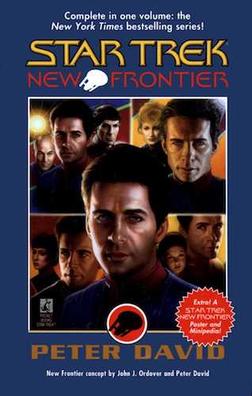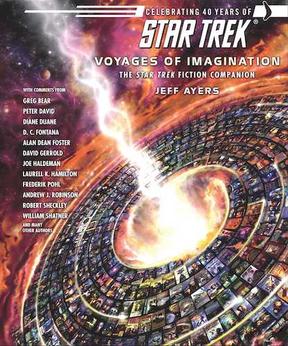 | |
| Author | Dafydd Ab Hugh |
|---|---|
| Series | Star Trek: The Next Generation |
| Genre | Science fiction |
Publication date | 1994 |
Balance of Power is a Star Trek: The Next Generation novel by Dafydd Ab Hugh.
 | |
| Author | Dafydd Ab Hugh |
|---|---|
| Series | Star Trek: The Next Generation |
| Genre | Science fiction |
Publication date | 1994 |
Balance of Power is a Star Trek: The Next Generation novel by Dafydd Ab Hugh.
When a famous Federation scientist dies, his son puts his inventions up for sale to the highest bidder—whether Federation, Klingon, Romulan or Cardassian. Among the items at auction are medical devices, engineering advances—and a photon pulse cannon capable of punching through a starship's shields with a single shot.
Meanwhile, at the Academy, Wesley Crusher comes to the aid of his best friend—and finds himself kidnapped by outlaw Ferengi bent on controlling the universe through commerce. When they also set their sights on the photon cannon, Captain Picard must find a way to save the Starship Enterprise and the Federation from the deadliest weapon ever known—with every race in the galaxy aligned against him.
Following Dafydd Ab Hugh's first Star Trek novel, Fallen Heroes , he discovered that he earned more money from writing these types of books than those outside of the franchise. This and the introduction of the gold pressed latinum as a currency in Star Trek: The Next Generation and Star Trek: Deep Space Nine influenced him to write a novel about this subject matter. [1] He stated that since latinum could not be replicated in-universe, it seemed natural to have a plot where someone discovered how to. He believed that such a plot would eventually appear elsewhere by another writer, and so decided to use it himself. [2]

The Romulans are an extraterrestrial race in the American science fiction franchise Star Trek. Their adopted home world is Romulus, and within the same star system they have settled a sister planet Remus. Their original home world, Vulcan, was renamed Ni'Var later in canon. They first appeared in the series Star Trek (1966–1969). They have appeared in most subsequent Star Trek releases, including The Animated Series, The Next Generation, Deep Space Nine, Voyager, Enterprise, Discovery, Picard, Strange New Worlds, and Lower Decks. They appear in the Star Trek feature films Star Trek V: The Final Frontier (1989), Star Trek VI: The Undiscovered Country (1991), Star Trek: Nemesis (2002) and Star Trek (2009). They also appear in various other spin-off media, including books, comics, toys and games.
The Star Trek fictional universe contains a variety of weapons, ranging from missiles to melee. The Star Trek franchise consists mainly of several multi-season television shows and a dozen movies, as well as various video games and inspired merchandise. Many aspects of the Star Trek universe impact modern popular culture, especially its fictitious terminology and the concept of weaponry on spacecraft. The franchise has had a widespread influence on its audiences from the late 20th to early 21st century. Notably, Star Trek's science fiction concepts have been studied by real scientists; NASA described it in relation to the real world as "entertaining combination of real science, imaginary science gathered from lots of earlier stories, and stuff the writers make up week-by-week to give each new episode novelty." For example, NASA noted that the Star Trek "phasers" were a fictional extrapolation of real-life lasers, and compared them to real-life microwave based weapons that have a stunning effect.
In Star Trek a replicator is a machine that can create things. Replicators were originally seen to simply synthesize meals on demand, but in later series much larger non-food items appear. The technical aspects of replicated versus "real" things is sometimes a plot element.

"The Neutral Zone" is the season finale of the first season of the American science fiction television series Star Trek: The Next Generation, originally aired within the United States on May 16, 1988, in broadcast syndication. The episode originated as a story submission purchased by Paramount written by Deborah McIntyre and Mona Clee, and was turned into a teleplay by Maurice Hurley. Because of the 1988 Writers Guild of America strike, Hurley created the script in a day and a half, and the timescale forced the abandonment of both the idea of a two-part episode and of the first appearance of the Borg, which was delayed until the following season episode "Q Who".
In the Star Trek franchise, the Klingon Empire makes use of several classes of starships. As the Klingons are portrayed as a warrior culture, driven by the pursuit of honor and glory, the Empire is shown to use warships almost exclusively and even their support ships, such as troop transports and colony ships, are armed for battle. This contrasts with the exploration and research vessels used by Starfleet, the protagonists of the franchise. The first Klingon ship design used in The Original Series, the D7-class battlecruiser, was designed by Matt Jefferies to evoke a shape akin to that of a manta ray, providing a threatening and instantly recognizable form for viewers. The configuration of Jefferies's design featured a bulbous forward hull connected by a long boom to a wing-like main hull with the engine nacelles mounted on each wingtip. Though a variety of Klingon ships have appeared in Star Trek, their design generally conforms to this style. Most Klingon vessels were physically built as scale models, although later computer-generated imagery was used to create the models. In recent years, many of the original studio models have been sold at auctions.

"Unification" is a two-part episode of the syndicated American science fiction television series Star Trek: The Next Generation which features Leonard Nimoy as Spock. The first of the two episodes earned a 15.4 household Nielsen rating, drawing over 25 million viewers, making it one of the most watched episodes in all seven seasons of The Next Generation's run.
"The Royale" is the twelfth episode of the second season of the American science fiction television series Star Trek: The Next Generation, the 38th episode overall. It was originally released on March 27, 1989, in broadcast syndication.

Star Trek: New Frontier is a series of interlinked novels written by Peter David, published by Simon & Schuster imprints, Pocket Books, Pocket Star, and Gallery Books, from 1997 to 2015. New Frontier was the first Star Trek tie-in fiction property not to be based on a television series. The series was created by John J. Ordover.
This article discusses the fictional timeline of the Star Trek franchise. The franchise is primarily set in the future, ranging from the mid-22nd century to the late 24th century, with the third season of Star Trek: Discovery jumping forward to the 32nd century. However the franchise has also outlined a fictional future history of Earth prior to this, and, primarily through time travel plots, explored both past and further-future settings.
"All Good Things..." is the series finale of the syndicated American science fiction television series Star Trek: The Next Generation. It comprises the 25th and 26th episodes of the seventh season and is the 177th and 178th episodes of the series overall. It aired on May 23, 1994. The title is derived from the expression "All good things must come to an end", a phrase used by the character Q during the episode itself.
"Descent" is the 26th episode of the sixth season and the first episode of the seventh season of the American science fiction television series Star Trek: The Next Generation, the 152nd and 153rd episodes overall.
"Relics" is the 130th episode of the syndicated American science fiction television series Star Trek: The Next Generation, the fourth episode of the sixth season.
"The Survivor" is the sixth episode of the first season of the American animated science fiction television series Star Trek: The Animated Series. It first aired on NBC on October 13, 1973, and was written by James Schmerer and directed by Hal Sutherland. Schmerer pitched an idea for an episode to producer D.C. Fontana called "The Chameleon", and together with the series creator Gene Roddenberry, it was developed into the final script.

Strike Zone is a Star Trek: The Next Generation novel by Peter David, published by Pocket Books in March 1989. It was the author's first novel set in the Star Trek universe, although he had previously written stories for the DC Comics line of comics. Strike Zone was originally intended to feature the Romulans but this was scrapped, with the new aliens called the Kreel replacing them. It was also meant to feature the crew of the Enterprise from Star Trek: The Original Series but the publishers asked David to use those from The Next Generation instead.

Voyages of Imagination: The Star Trek Fiction Companion (2006) is a reference work by Jeff Ayers published by Pocket Books. The book contains entries on the production and publication of Star Trek tie-in novels published from 1967 to 2006. Included are brief synopses of plots for each featured novel.

Star Trek: Section 31 is a series of thematically linked novels that explore the operations of the clandestine organization known as Section 31. The series was published by Pocket Books from 2001 to 2017, and initially spanned four Star Trek book lines, including The Next Generation, Deep Space Nine, and Voyager.
The following outline is provided as an overview of and topical guide to Star Trek: